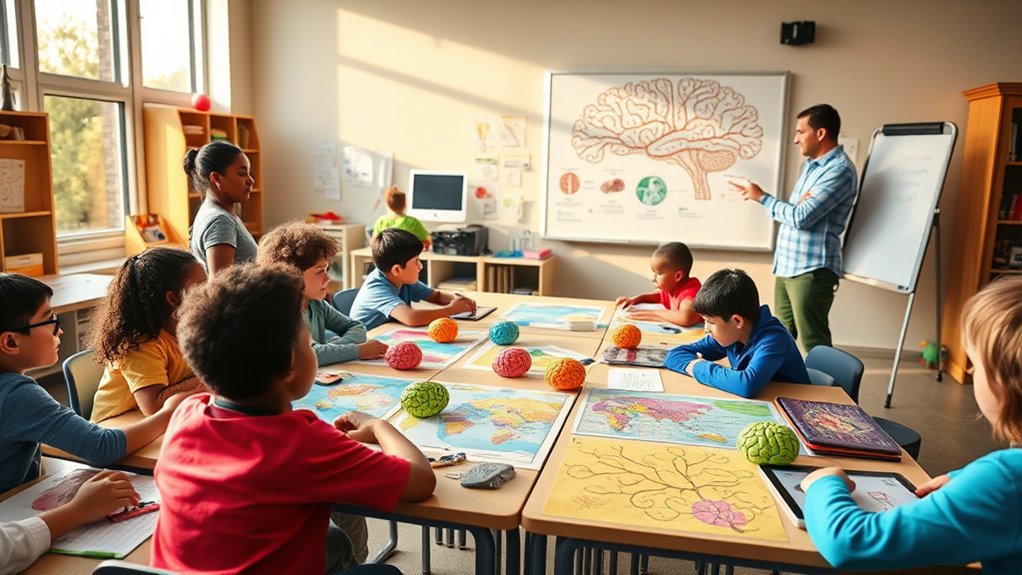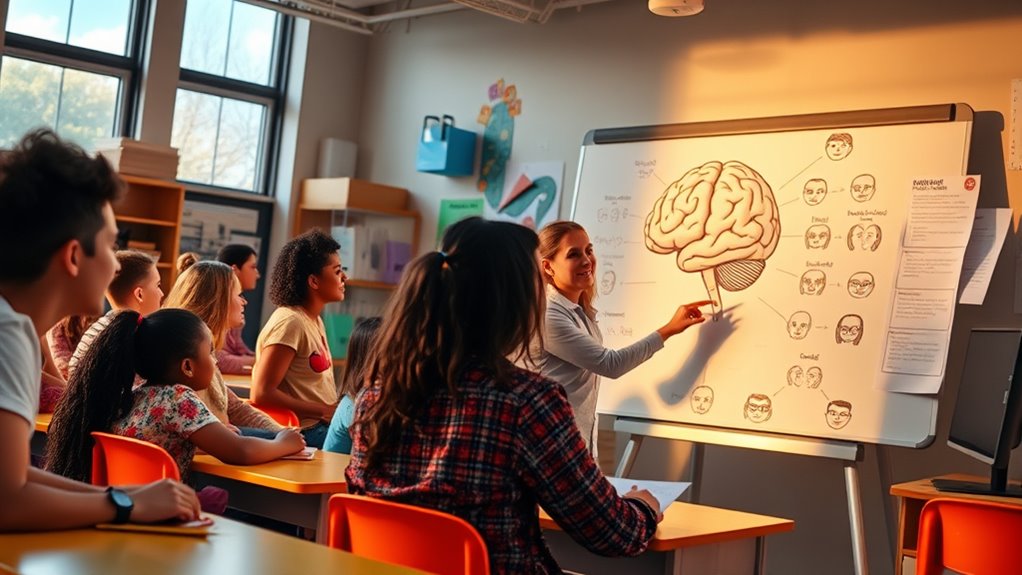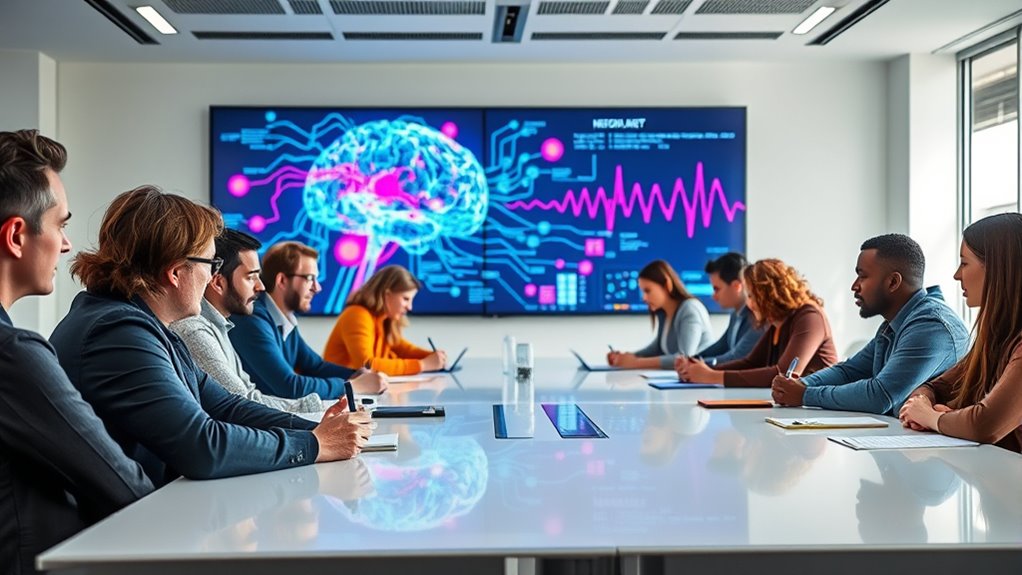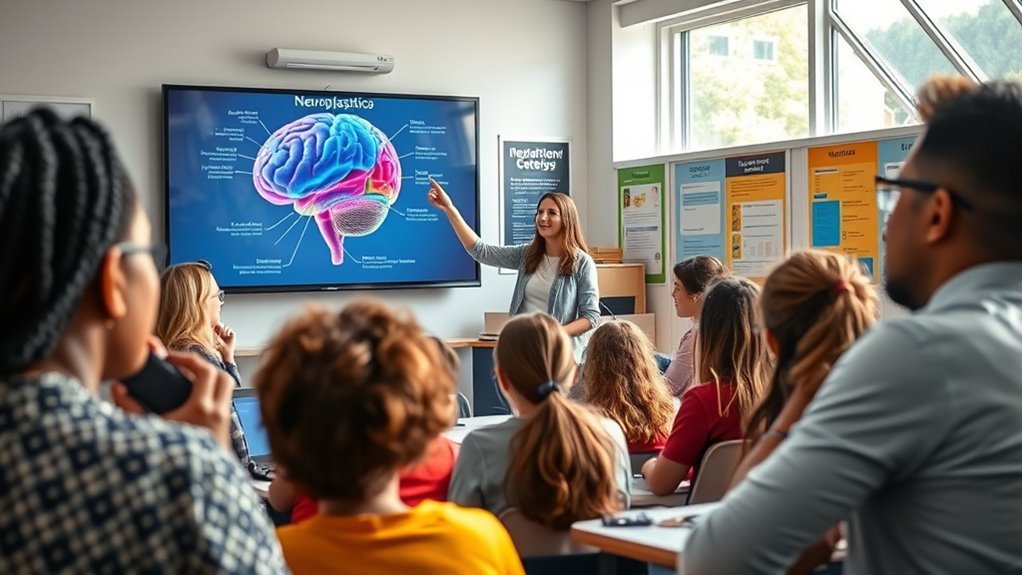Neuroeducation helps you enhance teaching by applying neuroscience principles that match how the brain naturally learns. You can activate multiple senses through visuals, sounds, and tactile activities, making lessons more memorable. Personalize strategies to meet diverse student needs, especially for neurodiverse learners. Incorporate movement, emotional connections, and hands-on experiences to boost engagement and motivation. To truly master these techniques, exploring further will reveal ways to create a more effective, brain-friendly classroom environment.
Key Takeaways
- Incorporate multisensory activities to activate various brain regions and enhance memory retention.
- Use movement breaks and hands-on experiences to promote neural plasticity and improve focus.
- Personalize instruction based on individual cognitive profiles, leveraging visual aids and flexible pacing.
- Foster emotional connections and a positive environment to boost motivation and emotional regulation.
- Stay informed on neuroscience research to adapt teaching strategies that align with brain learning processes.
Integrating Brain-Based Learning Strategies Into the Classroom

How can you effectively incorporate brain-based learning strategies into your classroom to enhance student engagement and retention? Start by designing lessons that activate multiple senses—use visuals, sounds, and tactile activities—to engage different brain regions and improve memory. Incorporate regular movement breaks, as physical activity boosts brain plasticity and helps students focus. Use storytelling and emotional connections to make content meaningful, tapping into the brain’s emotional regulation pathways. Vary your teaching methods to accommodate diverse learning styles, ensuring each student’s needs are met. Encourage active participation through discussions and collaborative tasks, fostering deeper processing. Ultimately, provide opportunities for reflection and review, which strengthen memory consolidation. By aligning your strategies with how the brain naturally learns, you’ll create a more dynamic, inclusive, and effective classroom environment. Additionally, incorporating dynamic communication exercises for couples can enhance interpersonal understanding and empathy, which are crucial for a supportive learning atmosphere.
Personalizing Education Through Neurodiverse Approaches

Personalizing education through neurodiverse approaches involves tailoring instructional strategies to meet the unique cognitive profiles and learning needs of each student. You recognize that every learner’s brain processes information differently, so you adapt your methods accordingly. For example, some students may benefit from visual aids, while others thrive with hands-on activities. You incorporate flexible pacing, varied sensory inputs, and alternative communication styles to support diverse neurodevelopmental profiles such as autism, ADHD, or dyslexia. Understanding individual strengths and challenges is essential for creating an inclusive environment** that promotes engagement and confidence. This personalized approach not only enhances learning outcomes** but also respects each student’s unique way of thinking and processing, fostering a sense of belonging and motivation.
Enhancing Engagement With Multisensory and Experiential Methods

Engaging students effectively requires integrating multisensory and experiential learning methods that activate various brain regions simultaneously. You can do this by combining visual, auditory, and tactile activities, which stimulate different neural pathways and reinforce understanding. Hands-on experiments, real-world projects, and role-playing make learning more dynamic and memorable. These approaches leverage brain plasticity, encouraging neural connections to form and strengthen through active participation. When learners experience content through multiple senses, they’re more likely to retain information and stay motivated. Incorporating movement, visuals, sounds, and tangible objects keeps students engaged and taps into their natural curiosity. Additionally, designing lessons that incorporate varied sensory stimuli can enhance neural engagement even further. By creating lessons that are rich in sensory input and experiential opportunities, you foster deeper learning and sustained interest.
Building Emotional and Motivational Foundations for Learning

Have you ever wondered why emotional states deeply influence learning success? Your students’ feelings impact their motivation, attention, and memory. When learners feel safe, supported, and engaged, their brains release neurotransmitters like dopamine and oxytocin, which enhance focus and foster a positive mindset. Conversely, stress or anxiety can hinder neural pathways involved in learning, making it harder to absorb new information. To build strong emotional foundations, create a classroom environment that promotes trust, empathy, and encouragement. Recognize and validate students’ emotions, helping them develop emotional regulation skills. When students feel emotionally secure, they’re more likely to take risks, stay motivated, and persist through challenges. Strengthening these emotional and motivational roots supports deeper learning and long-term retention. Additionally, leveraging the power of imagination can inspire students to envision new possibilities, fueling their motivation and resilience in the learning process.
Developing Neuroscientific Literacy to Improve Teaching Effectiveness

Developing neuroscientific literacy is essential for teachers who want to enhance their effectiveness in the classroom. When you understand how the brain learns, you can design strategies that truly resonate with your students. To build this literacy, focus on these key areas:
- Learn basic brain functions related to memory, attention, and emotion, so you can tailor your methods accordingly.
- Stay updated on neuroscience research to discern valid evidence from myths or misconceptions.
- Apply insights about neuroplasticity to create flexible, adaptive learning experiences.
- Use this knowledge to interpret student behaviors through a neuroscientific lens, improving your responses and support.
Frequently Asked Questions
How Can Teachers Assess Students’ Neurocognitive Profiles Accurately?
You can assess students’ neurocognitive profiles accurately by using a combination of formal assessments, observational techniques, and student self-reflections. Incorporate cognitive tests, analyze learning behaviors, and gather feedback on their preferences and challenges. Engage in ongoing dialogue with students to understand their unique strengths and needs. By combining these methods, you gain an extensive view of their neurocognitive profiles, enabling you to tailor instruction effectively.
What Are the Best Evidence-Based Methods to Support Neuroplasticity in Classrooms?
You can support neuroplasticity in your classroom by incorporating multisensory activities that engage multiple brain regions simultaneously, fostering stronger neural connections. Active learning through problem-solving, hands-on projects, and collaborative tasks stimulates rewiring and adaptability. Additionally, providing spaced repetition and varied instructional methods keeps the brain challenged and responsive. Encouraging emotional engagement and motivation further reinforces learning, helping students develop flexible, resilient neural pathways for lifelong growth.
How Does Emotional Regulation Influence Long-Term Learning Retention?
When you help students regulate their emotions, you create a safer space for learning, which boosts long-term retention. Emotional regulation reduces stress, enhances focus, and fosters motivation, making it easier for students to encode and consolidate information. By teaching strategies like mindfulness or deep breathing, you support emotional stability, ensuring that students can engage deeply with content, leading to stronger memories and improved retention over time.
What Are Common Misconceptions About Applying Neuroscience in Education?
Some folks think applying neuroscience in education is a quick fix, but it’s more like planting seeds for growth. You might believe that brain-based methods guarantee instant results, yet real progress needs patience and adaptation. Remember, neuroscience offers valuable insights, but it’s not a magic wand. Instead, use it as a guide to craft thoughtful, evidence-informed strategies that honor each learner’s unique neural landscape.
How Can Educators Stay Updated With Emerging Neuroeducation Research?
You can stay updated with emerging neuroeducation research by subscribing to reputable journals, attending conferences, and participating in professional development courses. Follow influential neuroscientists and educational researchers on social media, join online communities, and engage with webinars and workshops. Regularly read books and articles that translate neuroscience findings into practical teaching strategies. Being proactive and curious helps you integrate the latest insights into your classroom practices effectively.
Conclusion
By applying neuroscience principles, you can transform your teaching and boost student success. For example, studies show that multisensory learning increases retention by up to 70%. When you personalize lessons to diverse needs and create engaging, emotionally supportive environments, you foster deeper understanding and motivation. Developing neuroscientific literacy empowers you to implement effective strategies confidently. Embrace neuroeducation, and watch your students thrive as their brains open new potential every day.








